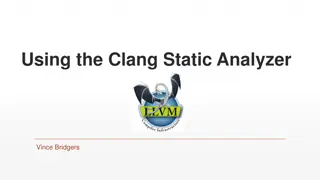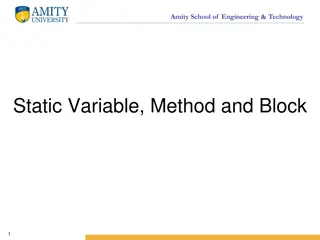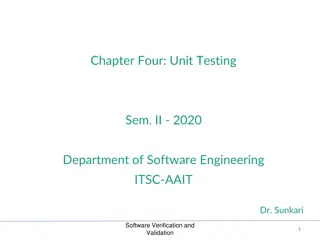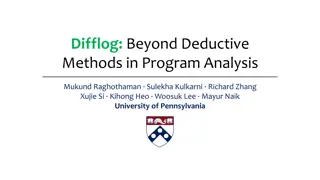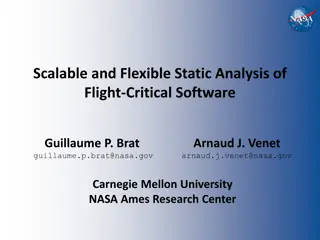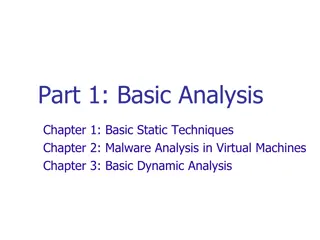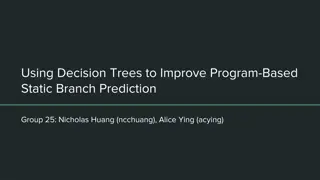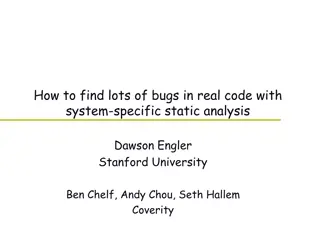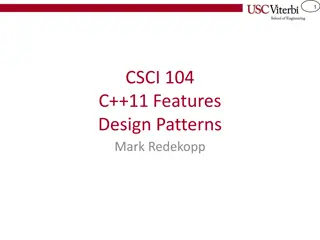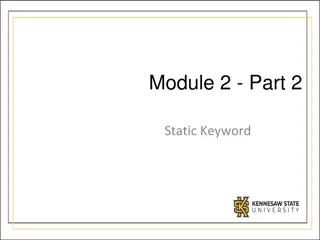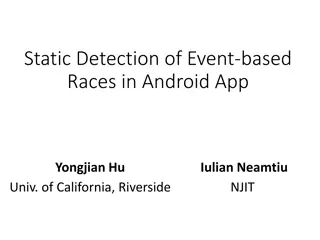Introduction to Static Analysis in C.K. Chen's Presentation
Explore the fundamentals of static analysis in C.K. Chen's presentation, covering topics such as common tools in Linux, disassembly, reverse assembly, and tips for static analysis. Discover how static analysis can be used to analyze malware without execution and learn about the information that can and cannot be obtained through static analysis. Delve into the usage of static analysis, its complement to dynamic analysis, and the first steps in conducting static analysis using Linux commands.
Download Presentation

Please find below an Image/Link to download the presentation.
The content on the website is provided AS IS for your information and personal use only. It may not be sold, licensed, or shared on other websites without obtaining consent from the author. Download presentation by click this link. If you encounter any issues during the download, it is possible that the publisher has removed the file from their server.
E N D
Presentation Transcript
Intro. To Static Analysis C.K. Chen 2014.09.23
Outline Intro. To Static Analysis Common Tools inLinux for Static Analysis Disassemble Reverse Assambly to C Fundamental ASM IDA Pro Pracetice Tips for Static Analtsis
Intr. to Static Analysis Static analysis Analysis malware without execution Dynamic analysis Execute malware inside controllable environment and monitor it s behavior
Information from Static Analysis What information we can get from static analysis
Information from Static Analysis What information we can get from static analysis File Structure Binary Code Related Module Suspicious String
Information from Static Analysis What we cannot get? Register Value Memory Value Packed Code Encrypted Message
Usage of static analysis In normal case, there are some problem that static analysis is involved Reverse: Windows, Linux Pwned(Exploit): Linux, Windows(rare) Complement to the dynamic analysis
First step to Static Analysis There are some Linux command that can give use information of file Strings Objdump Hexdump File
Linux Command Strings For each file given, GNU strings prints the printable character sequences that are at least 4 characters long and are followed by an unprintable character. Get clues of file
Linux Command File File tests each argument in an attempt to classify it. There are three sets of tests, performed in this order: filesystem tests, magic number tests, and language tests. The first test that succeeds causes the file type to be printed.
Linux Command Hexdump The hexdump utility is a filter which displays the specified files, or the standard input, if no files are specified, in a user specified format. Hex, Oct, Char, ..
Linux Command ldd - print shared library dependencies Loading library Location of library file Loading address of library
Linux Command Objdump Dump information of ELF file Rice information can be dumped Can used to build simplest malware analysis system
Disassemble objdump -D
Global Offset Table objdump R Key of sharing library in linux GOT Hijack
Disassemble Disassemble is a procedure to covert binary machine code into assembly code
Information inside Disassemble Instruction used in executable Data used in executable
Code Discovery Problem In the binary file, instructions and data may hybrid in the section. It is not easy to discover instructions in the binary Especial for variable-length instruction set like x86
Linear sweep Starts usually to disassemble from the first byte of the code section in a linear fashion Disassembles one instruction after another until the end of the section is reached Do not understand program flow objdump
Recursive traversal instruction classified as Sequential flow: pass execution to the next instruction that immediately follows Conditional branching: if the condition is true the branch is taken and the instruction pointer must change to reflect the target of the branch, otherwise it continues in a linear fashion (jnz, jne, . . . ). In static context this algorithm disassemble both paths Unconditional branching: the branch is taken without any condition; the algorithm follows the (execution) flow (jmp) Function call: are like unconditional jumps but they return to the instruction immediately following the call Return: every instructions which may modify the flow of the program add the target address to a list of deferred disassembly. When a return instruction is reached an address is popped from the list and the algorithm continues from there (recursive algorithm). Some issue Indirect code invocations Does returning from a call always allow for a faithful disassembly
Problem of Disassembly Remember that disassembler may not always true Linear sweep jmp .destination db 0x6a ; garbage byte technique .destination: pop eax eb 01 jmp 0x401003 6a 58 push 0x58 Recursive traversal push DWORD .destination jmp DWORD [esp] db 0x6a ; garbage byte technique .destination: pop eax push DWORD .destination jmp DWORD [esp] push 0x58
Reverse Assambly to C Registers Architecture The EIP register contains the address of the next instruction to be executed if no branching is done.
Memory Layout Stack Not maintain in Executable Local Variable Heap Not maintain in Executable Dynamic Allocate Memory BSS Section Uninitialized Data Global variables and static variables that are initialized to zero or do not have explicit initialization in source code Data Section Initialized Data Global variables and static variables
Variables Disassembled code for local and global variables
Local Variables/Arguments Caller push argument into stack Caller push eip by call instruction Callee save/push the caller s ebp Callee reserve space for local variables sub Stack Growing Direction
Data Movement MOV dst, src Src <= dst LEA dst, src Load effective address of operand into specified register To calculate the address of a variable which doesn't have a fixed address Example mov eax, [ebp - 4] <= get content in [ebp - 4] mov eax, ebp 4 <= wrong, no such instruction lea eax, [ebp - 4] <= get address of [ebp - 4]
Arithmetic Operator add dest, src sub dest, src mul arg div DIV r/m8 DIV r/m16 DIV r/m32 inc dec
Control Instructions Flag, each instruction updates some field of flag for future branch test Performs a bit-wise logical AND sets the ZF(zero), SF(sign) and PF(parity) flags cmp Performs a comparison operation between arg1 and arg2 Set SF, ZF, PF, CF, OF and AF
Branch Instruction JE Jump if Equal ZF=1 JNE Jump if Not Equal ZF=0 JG Jump if Greater (ZF=0) AND (SF=OF) JGE Jump if Greater or Equal SF=OF JL Jump if Less SF OF JLE Jump if Less or Equal (ZF=1) OR (SF OF)
Stack Operation Stack is the LIFO data structure PUSH: put data into top of stack POP: get data from top of stack
Function Call Call Similar to jmp, but a CALL stores the current EIP on the stack RET Load the address in esp, and jump to that address RET num Increase esp by num Load the address in esp, and jump to that address
Function Pro Function Prologue Store current EBP Save ESP to current EBP Leave space for local variables Function Epilogue Set ESP to EBP Restore EBP
Calling Convension The transition of function arguments must be maintain by assembly programmer, but most case maintain by compiler Stdcall function arguments are passed from right to left the calle is in charge of cleaning up the stack. Return values are stored in EAX. cdecl The cdecl (short for c declaration) is a calling convention that originates from the C programming language and is used by many C compilers for the x86 architecture. The main difference of cdecl and stdcall is that in a cdecl, the caller, not the calle , is responsible for cleaning up the stack. pascal The pascal calling convention origins from the Pascal programming language The main difference between it and stdcall is that the parameters are pushed to the stack from left to right. fastcall The fastcall is a non-standardized calling convention. the fastcall convention tends to load them into registers. This results in less memory interaction and increases the performance of a call.
Function Call Structure Function Call Structure
Branch Structure Branch Structure
Do-For loop Do-For loop
IDA Pro IDA Pro is the most well-known dissemble/decompile tool for reversing Disassemble Friendly GUI Decopiler Debugger
Overview Assembly and Control Flow View Control Flow View Message View
Functionality(1) Fun Call Window Graph Convert Current Location DATA Instruction String Self-defined Data Structure Array Convert Oprand Offset Hex/Oct/Dec/Bin Constant Char Segment-based Var Stack-based Var . Xref Table Once The disassemble make mistake, you can fix it yourself
Functionality(2) Import Function Functions included from other files Import function can help you to guess the behavior of program Names Function Name Variable Names Strings For problem with debugger information inside, names can be useful Export Function List functions export to other Binary DLL, entry point Strings All strings use For some easy problem, this can help you to get flag For other problem, it still give you quick look to program
Useful Hotkeys List of useful hotkeys Function Hotkey 1 Strings Shift+F12 2 Jump to operand Enter 3 Jump to previous position ESC 4 Jump to next position Ctrl+Enter 5 Jump to address G 6 Jump to entry point Ctrl+E 7 Sequence of bytes Alt+B
Practice Reverse encryption algo in bot.exe
Decompiler Decompiler can help you to transfer assembly into C code More easy to read
But Decompiler result is not perfect Most of time is buggy Lack of source code level information May not support All platform Arm X86 X64 ..
Reversing Concept Identify important part of program Backward tracking user data Forward tracking interesting API function Convert back to C code
Identify important part of program Identify what you interesting Strings: flag , key , . Function to read input: scanf(), gets(), Function for network communication: recv(), send() Read/Write file ..
Backward tracking user data Most program vulns must be trigger by user input You can not(or difficult) to attack a function independent to your input Keep track about variables affect by your input Data Propagate Data Dependency
Forward tracking interesting API function Most vuln are cause by some certain functions strcpy() memcpy() scanf() printf() strcat() .. Try to trigger these functions Analysis control flow and make strategy to enforce program goto these functions
Convert back to C code 1. Gather information IAT strings dynamic analysis 2. Identify function of interest 3. Identify CALLs 4. Identify algorithms and data structures 5. Pseudo-code it! 6. Rename function(s), argument(s), variable(s)







